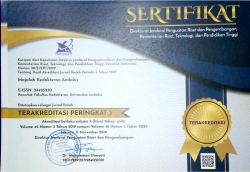Prognostic factors influencing prolonged ventilation after open mitral valve surgery
Abstract
Objective: To determine prognostic factors influencing prolonged ventilation after surgery in our hospital. Method: Seventy-five patients fulfilled inclusion criteria were included in this retrospective cross-sectional study. Prognostic factors analyzed were age, chronic pulmonary disease, heart failure (NYHA class function), left ventricular (LV) dysfunction (based on ejection fraction), recent myocardial infarction, pulmonary hypertension (PH), duration of cardiopulmonary bypass (CPB), ischemic time and aorta clamp time, which were analyzed in relation to prolonged ventilation after open mitral valve surgery. Results: Subjects were 75 patients aged between 19 and 62 years old (mean 39.76, SD 11.44) whom underwent open mitral valve repair or replacement surgery. Twenty-three patients (30.67%) had prolonged ventilation (≥24 hours) after surgery. Bivariate analysis showed there were no significant correlation between age, heart failure, PH and LV dysfunction. There are different with statistically significance between groups (p<0.05). Conclusions: In this study, almost one-third of patients had prolonged ventilation after surgery. Factors influencing this morbidity were the duration of ischemic time, aorta clamp time and CPB. Age, heart failure, LV dysfunction and PH were not statistically related to the prolonged ventilation event.
Keywords
Full Text:
PDFReferences
Coffey S, Cox B, Williams MJ. Lack of progress in valvular heart disease in the pre–transcatheter aortic valve replacement era: Increasing deaths and minimal change in mortality rate over the past three decades. Am Heart J. 2014; 167(4):562-567.e2. doi: 10.1016/j.ahj.2013.12.030. [PubMed].
Ribeiro GS, Tartof SY, Oliveira DWS, Guedes ACS, Reis MG, Riley LW, et al. Surgery for valvular heart disease: a population-based study in a Brazilian urban center. PLoS One. 2012; 7(5):e37855. doi: 10.1371/journal.pone.0037855. [PubMed].
Kappetein AP, Head SJ, Genereux P, Piazza N, van Mieghem NM, Blackstone EH, et al. Updated standardized endpoint definitions for transcatheter aortic valve implantation: the Valve Academic Research Consortium-2 consensus document (VARC-2). Eur J Cardiothorac Surg. 2012; 42(5):S45-60. doi: 10.1093/ejcts/ezs533. [PubMed].
Antunes PE, de Oliveira JF, Antunes MJ. Risk-prediction for postoperative major morbidity in coronary surgery. Eur J Cardiothorac Surg. 2009; 35(5):760-6. doi: 10.1016/j.ejcts.2008.10.046. [PubMed].
Andrade ING, Moraes Neto FR de, Andrade TG. Use of EuroSCORE as a predictor of morbidity after cardiac surgery. Rev Bras Cir Cardiovasc. 2014; 29(1):9-15. doi: 10.5935/1678-9741.20140005. [PubMed].
Priyatno W. Faktor Prognostik Pada Operasi Katup Jantung Di Rsup Dr Sardjito Yogyakarta. [Tesis]. Yogyakarta: Universitas Gajah Mada; 2015.
Asmaya AP. Fraksi Ejeksi, Gagal Jantung Kelas Fungsional Nyha Dan Umur Sebagai Faktor Prognostik Pada Operasi Penggantian Katup Mitral Jantung Di Rsup Dr Sardjito. [Tesis]. Yogyakarta: Universitas Gajah Mada; 2017.
Yanquez FJ, Clements JM, Grauf D, Merchant AM. Synergistic effect of age and body mass index on mortality and morbidity in general surgery. J Surg Res. 2013; 184(1):89-100. doi: 10.1016/j.jss.2013.05.009. [PubMed].
Ruiz-García J, Lerman A, Weisz G, Maehara A, Mintz GS, Fahy M, et al. Age- and gender-related changes in plaque composition in patients with acute coronary syndrome: the PROSPECT study. EuroIntervention. 2012; 8(8):929-38. doi: 10.4244/EIJV8I8A142. [PubMed].
Chan KMJ, Punjabi PP, Flather M, Wage R, Symmonds K, Roussin I, et al. Coronary artery bypass surgery with or without mitral valve annuloplasty in moderate functional ischemic mitral regurgitation: final results of the Randomized Ischemic Mitral Evaluation (RIME) trial. Circulation. 2012; 126(21):2502-10. doi: 10.1161/CIRCULATIONAHA.112.143818. [PubMed].
Nashef SA, Roques F, Sharples LD, Nilsson J, Smith C, Goldstone AR, et al. EuroSCORE II. 2012; 41(4):734-44. doi: 10.1093/ejcts/ezs043. [PubMed].
Azarfarin R, Ashouri N, Totonchi Z, Bakhshandeh H, Yaghoubi A. Factors influencing prolonged icu stay after open heart surgery. Res Cardiovasc Med. 2014; 3(4):e20159. doi: 10.5812/cardiovascmed.20159. [PubMed].
Guerrero M, Urena M, Himbert D, Wang DD, Eleid M, Kodali S, et al. 1-Year Outcomes of Transcatheter Mitral Valve Replacement in Patients With Severe Mitral Annular Calcification. J Am Coll Cardiol. 2018; 71(17):1841-53. doi: 10.1016/j.jacc.2018.02.054. [PubMed].
Salis S, Mazzanti V V., Merli G, Salvi L, Tedesco CC, Veglia F, et al. Cardiopulmonary Bypass Duration Is an Independent Predictor of Morbidity and Mortality After Cardiac Surgery. J Cardiothorac Vasc Anesth. 2008; 22(6):814-22. doi: 10.1053/j.jvca.2008.08.004. [PubMed].
Al-Githmi I. Does Gender Affect the Outcomes of Multiple Valve Heart Surgery?. Open J Thorac Surg. 2012; 2(1):1-4. doi: 10.4236/ojts.2012.21001.





















